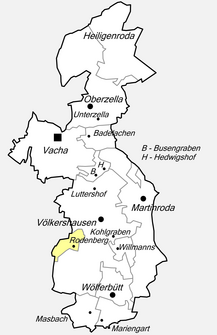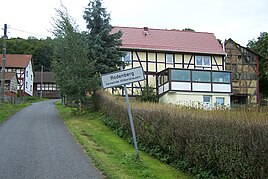Rodenberg (Vacha)
|
Rodenberg
City of Vacha
Coordinates: 50 ° 47 ′ 12 ″ N , 10 ° 1 ′ 40 ″ E
|
|
|---|---|
| Height : | 530 m above sea level NN |
| Residents : | 20 (Jun 30, 2009) |
| Postal code : | 36404 |
| Area code : | 036962 |
|
Location of Rodenberg in Vacha
|
|
|
View to Rodenberg (2012).
|
|
Rodenberg is a district of Vacha in the Wartburg district in Thuringia .
location
Rodenberg is a late medieval settlement in the saddle between the mountains Dietrichsberg in the south and Öchsen in the north. The geographic height of the place is 330 m above sea level. NN . The only publicly usable access is via an asphalt access road from Völkershausen, another asphalt road (private road) leads to the quarry and the unpaved road, which is only approved for forestry and agricultural vehicles, leads to Sünna.
history
The settlement was first mentioned in a document in 1323, but was abandoned again 70 years later. On March 1, 1432, the local aristocrat Tyle von Völkershausen issued a mortgage note to the Vach citizen Hans Witzel and his wife about the deserted Rodenberg and goods in Pferdsdorf . On October 6th, the Fulda monastery firm confirmed the sale of the Rodenberg to Hans Witzel . Apparently the feudal rights were also transferred to Witzel, a list of the Fulda fiefdoms from 1452 mentions Rodenberg and Pferdsdorf for the Witzel family in addition to other estates.
Rodenberg was only mentioned again at the beginning of the 16th century when a dispute broke out with the bailiff of Vacha about the course of the Völkershausen land border. The first contract concluded for this incident proved that the Rodenberg residents continued to belong to the Völkershausen rulership ; the Rodenbergers were also entitled to cultivate the adjacent areas of the Sünnaer Flur (pasture and drift rights). The Rodenberg backyards were built on the corridor boundary, and there were renewed disputes. The Rodenberger Höfe were now run as a district of Deicheroda in the Vacha district, the front courtyards were parish off to Völkershausen as usual, the back courtyards were parish off to Sünna. All school-age children attended the Völkershausen school (it was the closest). The current course of the field boundary was established and petrified in the 18th century. At the end of the 19th century there were still four courtyards. In 1949 the municipality of Völkershausen was awarded all courtyards and the corridor. On June 30, 2009, 20 people lived in Rodenberg. On the southern outskirts there is a small business for the utilization and production of firewood.
Attractions
- The basalt quarry on Dietrichsberg, which began around 150 years ago, and the Keltenhotel with the “Celtic Village”, which is already part of the neighboring town of Sünna, are located close to the village - an archaeological exhibition that began in the 1990s.
- As a “premium hiking trail”, the Celtic Path opens up the landscape of Öchsen and Dietrichsberg. The path marked with a red K is around 17 kilometers long and provides information about the cultural history of the region with a focus on the Celtic era.
- The “Öchsen cultural-historical nature trail”, which was laid out in the 1990s, also leads through Rodenberg, the numerous display boards also explain the flora and fauna of the Thuringian Rhön landscape. The hiking trail is looked after by the Völkershäuser Heimatverein Naturfreunde des Dietrichsberg eV.
literature
- Olaf Ditzel, Walter Höhn: Vacha and the neighboring communities in the Oechsetal . Michael Imhof Verlag, Petersberg / Fulda 2011, ISBN 978-3-86568-121-8 , p. 21-24 .
Web links
- "Sternwarte Rodenberg" - private homepage of a Rodenberger with some remarkable thunderstorm photos from 2005/2006 (lightning over the Oechsen)
- Aerial view of the basalt quarry with Rodenberg
Individual evidence
- ↑ Official topographic maps of Thuringia 1: 10,000. Wartburgkreis, district of Gotha, district-free city of Eisenach . In: Thuringian Land Survey Office (Hrsg.): CD-ROM series Top10 . CD 2. Erfurt 1999.
- ↑ Information boards on the local history on the Keltenpfad hiking trail and in the local area.
- ↑ Leaflet on the Celtic Path - available in the Celtic village of Sünna.


